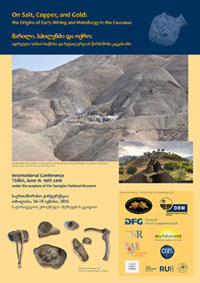
Colloque de restitution des résultats du programme MINES, ANR-DFG franco-allemande (2013-2016).
In the Caucasus, as in Europe and the Near East, the 5th and 4th millennia BCE are characterized by technological innovations that are seemingly linked with marked societal changes: the rise of mining industries, the development of extractive metallurgy and secondary animal-products appear to be coeval with the emergence of social hierarchy and increasing inequalities. But the processes that led to such spectacular evolutions, as well as the actual interactions between technology, innovations and socio-economic reorganisation, are still a matter of debate.
In the Caucasus, recent discoveries made both in Azerbaijan and Georgia suggest that extractive metallurgy had reached a high stage of development by the end of the 5th millennium BCE, while the earliest mines known to date, the gold mine of Sakdrissi in Georgia and the salt mine of Duzdagi in Azerbaijan, appear to be closely linked to the Kuro-Araxes phenomenon. Traces of intensive exploitation during the Kura-Araxes period are indeed attested on the mine works themselves, while numerous implements used in gold processing or salt extracting have been found respectively on the settlements of Dzezvebi and Kültepe 1, just a few kilometers away from the mines. A number of clues thus suggest that Kura-Araxe communities had a major role in the development of mining in the Caucasus, but their share in the actual development of metallurgy is not yet as clear.
Since the number of studies focused on these issues has greatly risen over the past ten years in the Caucasus and beyond, the time has come to assess the available data with a view to identifying the processes that led to the emergence of new products and production systems: we then need to discuss their social, economic and even political implications in the Caucasus and beyond.
- Du 16 au 19 juin 2016, Musée National de Géorgie, Tbilisi (Géorgie)
Affiche (.pdf)
Présentation (.pdf)
Programme (.pdf)